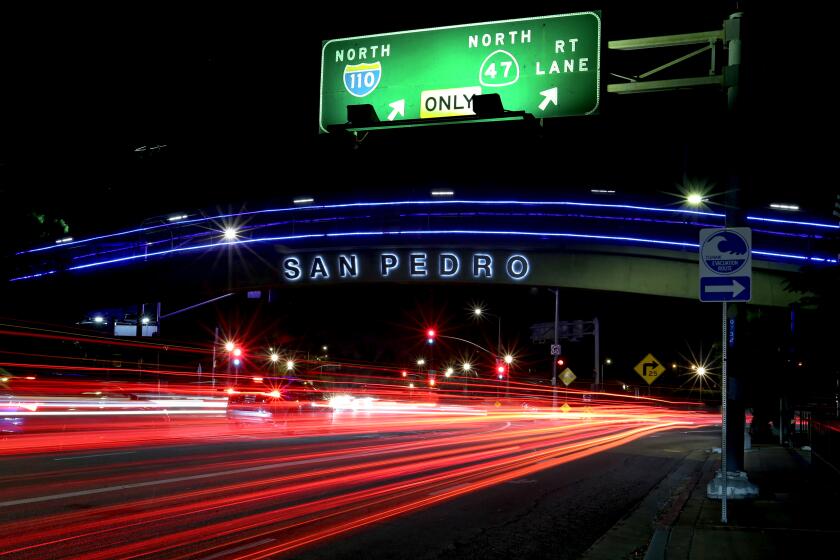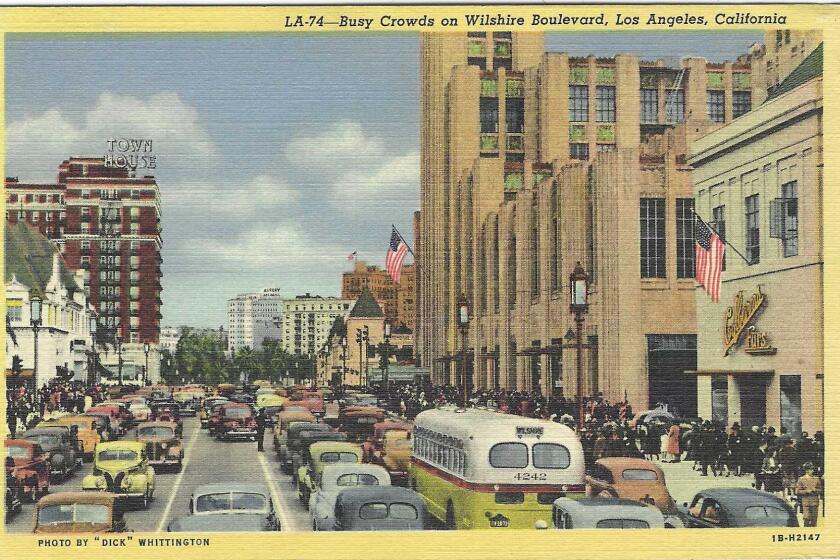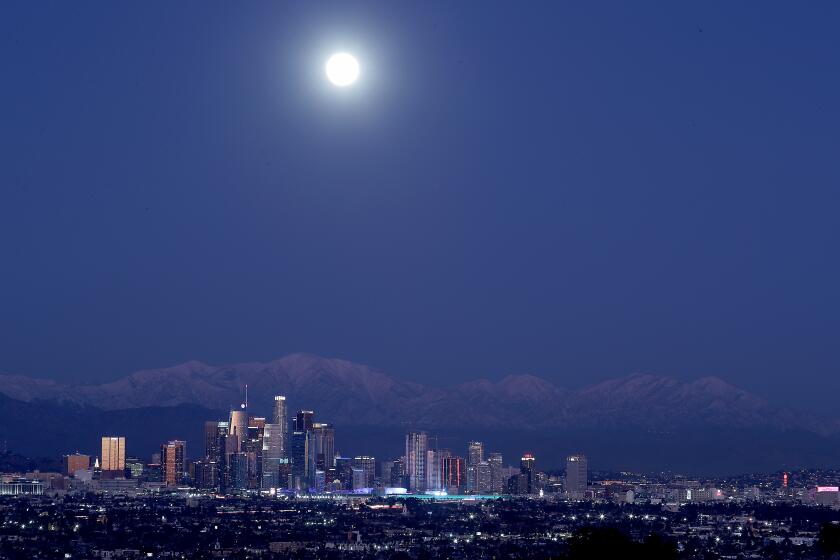Cold enough for you? Why air conditioning reigns supreme in Southern California
- Share via
Cold enough for you … ?
… asked no one living in our scorch-and-sizzle places. Not until the 1950s and ‘60s, anyway, by which time air conditioning altered our lives and living spaces almost as much as electric light and running water.
AC is such a standard of our living standard now that, enswirled as you may be at this moment by that sweet, sweet cool air, you might not even give it a thought — until the power bill comes.
And yet, where would you be without AC? Maybe not living here at all.
In 1975, LIFE magazine listed 100 events that changed the nation. One of them was the Louisiana Purchase. One of them was the atomic bomb. And one of them was the 1902 invention of modern air conditioning.
Air conditioning didn’t just change the indoors — letting us “cheat the atmospheric whims of Mother Nature,” as another issue of LIFE magazine put it, in 1944 — but it changed the outdoors, too, our public landscapes.
Explaining L.A. With Patt Morrison
Los Angeles is a complex place. In this weekly feature, Patt Morrison is explaining how it works, its history and its culture.
Southern California and parts of the American Southwest exist as they do today — populous and prosperous — principally because AC made them OK. If that 1962 epic movie “How the West Was Won” had ever spun the real tale of what won the West, it would have starred air conditioning installers, not gunslingers.
AC is so consequential that it has its own museum: the Air Conditioning and Refrigeration Museum, in a building just below downtown L.A. that’s also a headquarters and training center for air conditioning and related trades. The museum should be reopening its remodeled self next month. It will still showcase “Old Chiller,” the nearly hundred-year-old AC system — green as a sea serpent and almost as big — that once freshened the air at the Huntington Library.
Willis Carrier, an engineer whose surname is on multiple millions of AC units, did not set out to become a benefactor of sweaty humankind when he invented modern air conditioning in 1902. He was solving a problem at a New York printing plant that needed to control humidity to stop its four-color printing from running in the sweltering season.
Within 20 years, AC was big business — literally big: cooling skyscrapers, office buildings, hospitals, department stores and massive theaters. Long-haul trains competed for passengers by laying on air conditioned cars. The need to keep these systems clean was made clear in the nation’s bicentennial year of 1976. An outbreak of an odd illness at a hotel hosting American Legion conventioneers sickened 182 people, and 29 of them died. The cause was a bacteria growing in the cooling tower of the hotel’s AC system. The bacterial sickness came to be known as Legionnaires disease.
Three months after Franklin and Eleanor Roosevelt moved into the White House, in 1933, the nation learned that “The Roosevelt family is going to be comfortable even if it has to stay in Washington in summertime.” Air conditioners were installed in five rooms: FDR’s bedroom, his study, Eleanor’s bedroom (separate bedrooms, very upper-crust), their daughter’s room, and that of FDR’s indispensable adviser, Louis Howe.
In Los Angeles, founded for Spain and a part of Mexico for generations, we pronounce our Spanish-language place names in a unique way.
It’s a good thing movies were silent for as long as they were because, before the arrival of AC, the rattle of paper fans in the summertime audience would have drowned out the dialogue. Then, in 1923, Grauman’s Metropolitan theatre opened in downtown L.A., perhaps the earliest “air-cooled” movie palace system in the nation, almost certainly in the West. In 1925, Carrier installed AC in the Rivoli Theater in Manhattan. Air conditioning came to the movies just in time to keep audiences quiet enough to hear the talkies.
Once you start looking for AC tales, you can’t stop. HVAC engineers put together a webpage pointing out the implausibilities of duct systems in movies like “Die Hard.” Fans remember the 1955 Marilyn Monroe movie “The Seven Year Itch” for her skirts a-whirl above a subway grate, but the film’s plot revolves around New York in August, and seduction-by-air-conditioner.
For a nation mad about autos, it follows that car AC was one of the earliest consumer uses. The 1940 Packard was evidently first in that luxurious line of “factory air.” In 1944, a “futurist” Times story predicted that every car in the future would have a dashboard radio-telephone (right), be air-conditioned (right again), and cost $400 (two out of three; I’d take that to Vegas).
For the longest time, home air conditioning usually meant a noisy box mounted in a sash window. Central air was still unusual enough that in July 1937, B-picture actress Joan Woodbury got one of her rare mentions in The Times for installing air conditioning in her house.
World War II used up the raw materials that might have gone to AC, but peacetime suburban spenders made up for it. Just change around the numbers and the neighborhoods, and literally scores of Times real estate stories read like this one, from September 1965: “Some 165 refrigerated air conditioning units have been installed in the $12 million 565-home community of Sunshine Homes-Newhall.”
From mid-century to century’s end, Americans followed the air conditioning. The Sun Belt came to claim 40% of the nation’s population.
Steven Johnson, in his book “How We Got to Now: Six Innovations that Made the Modern World,” makes the remarkable but not implausible claim that California Gov. Ronald Reagan was able to become president in part because of air conditioning: AC made otherwise inhospitable zones from Arizona to Florida livable year-round, which led “more conservative retirees” to move south and west, and take their popular and electoral votes with them.
Central AC was still a new and costly enough thing that after World War II, the VA reassured veterans that they wouldn’t have to put down bigger down payments on their new houses if they added on air conditioning.
In September 1961, when L.A. County Sheriff Peter Pitchess begged for money for air conditioning in his new jail — cooler air makes prisoners more tractable — he made sure to call it “air control,” and the Board of Supervisors was so reluctant to rile up voters who might not enjoy “air control” at home that they punted it to a committee for further study.
Angelenos can be spotted a mile away in other locales, waiting for the walk sign while locals jaywalk with abandon. What’s that about? And what happens when people do jaywalk here?
Yet it’s a chill wind that blows completely good:
- Decades of air conditioners pummeled the environment and the atmosphere by dumping out CFCs, chlorofluorocarbons, chemicals that damage the ozone layer. There are several kinds, and their production and importation here has been phased out, but many older AC units can still use old stocks to keep them running.
- The global demand for air conditioning is rising apace with global temperatures, and that means more pressure on the energy grid — on fossil fuels like oil and coal, as well as cleaner energy. Between 2019 and 2060, electricity demand in L.A. could rise by 50%.
- One celebrated piece of AC lore is that during the energy crisis of the early 1970s, Richard Nixon — the only California-born president — would head for the Lincoln sitting room in the White House, or in his hideaway office in the Executive Office Building, switch on the AC full-blast, no matter the season, and settle in front of a fire crackling away in the fireplace. The author of a book about the redecoration program in the Nixon administration wrote that “fires seemed to comfort him.”
- Fifteen years ago, The Times reported that less than half the homes in the L.A. city limits had AC at all. The numbers are higher now, yet older houses and especially older apartments are less likely to have AC. Energy poverty is a real thing. Cold air and warm air cost money to make. People in the frigid East and Midwest might use heat sparingly because of the power bills, and overheated Californians do the same. The people who probably ease up on the AC, if they have it, are older, poorer, and people of color.
Into the 1920s, a lot of houses in L.A. had sleeping porches, screened-in verandas and decks for getting a good night’s rest in the cool outdoors. Temperatures were still pretty moderate then, even taking into account the propaganda hullabaloo of the “All Year Club.” That was an expensive promotional concoction to get winter visitors to come spend their money in L.A. the other eight or nine months of the year, too, inveigling them with come-ons like this one, from a hundred years ago: “Sleep under a blanket every night all summer in Southern California.”
Plain and simple: Yes, “it’s now a lot warmer than it used to be in Los Angeles and coastal Southern California more broadly.” That’s from Daniel L. Swain. He is a climate scientist at UCLA and a California climate fellow at the Nature Conservancy.
“The number of uncomfortably hot days has increased substantially over the past century, but especially in the last few decades, due to climate change.” On top of that, we’re generating a kind of feedback loop with urban heat islands, especially “since the Second World War, as the city’s footprint and extent of paved areas exploded over decades. Those two things together — climate change, plus the city’s propensity to “keep itself hot” via the heat island effect — have led to more uncomfortable temperatures more of the time,” and even sometimes at night, in case you’re thinking about making a sleeping porch of your own.
L.A. is a place like no other. You’ve got questions. Patt Morrison probably has answers and can definitely find out.
It has a nicely comic sound, yet the word “coolth” is a real word. It means, naturally, the opposite of “warmth,’ and its heyday was during the medieval climate era known as the “Little Ice Age.”
And if you’ve read all this way, you now know about the birth of “coolth” — and about the dearth of coolth.
More to Read
Sign up for Essential California
The most important California stories and recommendations in your inbox every morning.
You may occasionally receive promotional content from the Los Angeles Times.















